Book contents
- Frontmatter
- Contents
- PROLOGUE
- 1 CALCULUS PRELIMINARIES
- 2 DIFFERENTIABLE MANIFOLDS
- 3 SUBMANIFOLDS
- 4 DIFFERENTIABILITY
- 5 TANGENT SPACES AND MAPS
- 6 TANGENT BUNDLES AS MANIFOLDS
- 7 PARTIAL DERIVATIVES
- 8 DERIVING LAGRANGE'S EQUATIONS
- 9 FORM OF LAGRANGE'S EQUATIONS
- 10 VECTORFIELDS
- 11 LAGRANGIAN VECTORFIELDS
- 12 FLOWS
- 13 THE SPHERICAL PENDULUM
- 14 RIGID BODIES
- REFERENCES
- INDEX
- SYMBOL TABLE
PROLOGUE
Published online by Cambridge University Press: 28 January 2010
- Frontmatter
- Contents
- PROLOGUE
- 1 CALCULUS PRELIMINARIES
- 2 DIFFERENTIABLE MANIFOLDS
- 3 SUBMANIFOLDS
- 4 DIFFERENTIABILITY
- 5 TANGENT SPACES AND MAPS
- 6 TANGENT BUNDLES AS MANIFOLDS
- 7 PARTIAL DERIVATIVES
- 8 DERIVING LAGRANGE'S EQUATIONS
- 9 FORM OF LAGRANGE'S EQUATIONS
- 10 VECTORFIELDS
- 11 LAGRANGIAN VECTORFIELDS
- 12 FLOWS
- 13 THE SPHERICAL PENDULUM
- 14 RIGID BODIES
- REFERENCES
- INDEX
- SYMBOL TABLE
Summary
These notes began as an attempt to bridge the gap between undergraduate advanced calculus texts (such as Spivak(1965)) and graduate texts on differential topology. One of the major applications of differentiable manifolds is to the foundations of mechanics. Here a huge gap exists between the classical literature (see for example Goldstein (1980) and the more modern differentiable manifolds approach (see Abraham and Marsden(1978)). Dieudonne(1972) says “The traditional domain of differential geometry, namely the study of curves and surfaces in three-dimensional space, was soon realized to be inadequate, particularly under the influence of mechanics”. Two of the authors of this work have been involved in the writing of papers on problems in Lagrangian mechanics and they soon realized the need for a simple but modern treatment of the theoretical background to such problems.
Thus our aim is to make some of the basic ideas about manifolds readily available to applied mathematicians and theoretical physicists while at the same time exhibiting applications of an important area of modern mathematics to mathematicians.
Classical texts use vague ideas such as “virtual work” and “infinitesimal displacements” in their derivation of Lagrange's equations. By contrast the modern texts jump straight to Hamiltonian systems and lose the physical motivation. In these notes, the derivation of Lagrange's equations makes direct appeal to geometrical principles. As far as the authors are aware, these ideas do not appear elsewhere.
In his original work, Méoanique analytique, Lagrange used no diagrams. In fact the geometrical ideas necessary for a thorough understanding of classical mechanics did not exist at that time.
- Type
- Chapter
- Information
- Manifolds and Mechanics , pp. 1 - 2Publisher: Cambridge University PressPrint publication year: 1987



